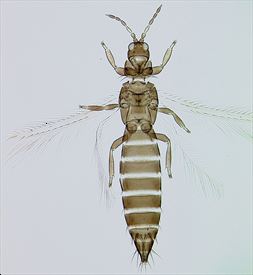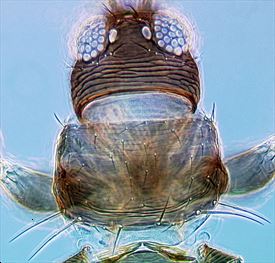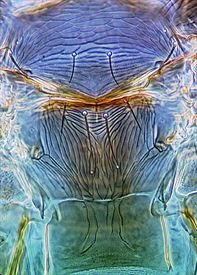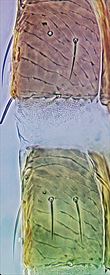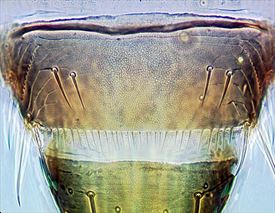Distinguishing features
Both sexes fully winged. Female brown, tarsi and antennal segment III yellow; fore wings pale. Antennae 8-segmented, III–IV constricted to distinct apical neck. Head as wide as long, cheeks convex, ocellar setae pair III arising on anterior margins of ocellar triangle and slightly longer than side of triangle; postocular setae pairs I & III shorter than ocellar setae pair III, pair II minute. Pronotum posterior margin with 3 (or 4) pairs of setae. Metanotum with parallel lines of sculpture medially converging at posterior, median setae arising near anterior margin; campaniform sensilla present. Fore wing first vein with 3 setae on distal half, second vein with complete row of about 14 setae. Tergite II with 3 lateral marginal setae; posterior margin of VIII with complete comb of long microtrichia; pleurotergites with 3 or 4 discal setae. Sternite II with few discal setae, III–VII with 15–20 discal setae in an irregular double row.
Male brown, smaller than female; tergite VIII without posteromarginal comb; sternites III–VII with broadly transverse pore plate in front of discal setae.
Related species
There are 13 species of the genus Thrips recorded from New Zealand, out of a total of 280 species worldwide (Mound & Masumoto, 2005). Many of these species have the antennae clearly 7-segmented, whereas others have 8 segments. All members of Thrips genus have paired ctenidia on the tergites, and on tergite VIII these are postero-mesad to the spiracles, and they also lack ocellar setae pair I in front of the first ocellus. In contrast, Frankliniella species have ctenidia on tergite VIII antero-lateral to the spiracles, and a pair of setae is always present in front of the first ocellus. The European species T. vulgatissimus is similar in general appearance to the New Zealand flower thrips, T. obscuratus, but differs from that as well as the other endemic New Zealand species of genus Thrips in having only two (rather than three) pairs of setae on the posterior margin of the second abdominal sternite. Moreover, the fore wing of T. obscuratus has two complete rows of veinal setae.
Biological data
This polyphagous species feeds and breeds in the flowers of various species, but commonly in white flowers of Caryophyllaceae.
Distribution data
Recorded infrequently in New Zealand (AK, HB, MC) and southern Australia, but widespread in Europe and North America.
Family name
THRIPIDAE, THRIPINAE
Species name
Thrips vulgatissimus Haliday
Original name and synonyms
Thrips vulgatissimus Haliday, 1836: 447
Physopus pallipennis Uzel, 1895: 110
Taeniothrips lemanis Treherne, 1924: 87
Taeniothrips vulgatissimus f. gracilis Priesner, 1926: 298
Taeniothrips vulgatissimus f. atricornis Priesner, 1926: 298
Taeniothrips americanus Moulton, 1929: 130
Physothrips gentianae Bagnall, 1933: 653
Taeniothrips tahvanus Hukkinen, 1936: 139
References
Mound LA & Masumoto M (2005) The genus Thrips (Thysanoptera, Thripidae) in Australia, New Caledonia and New Zealand. Zootaxa 1020: 1–64
Mound LA, Tree DC, Paris D (2012) Oz Thrips – Thysanoptera in Australia. http://www.ozthrips.org/
Mound LA & Walker AK (1982) Terebrantia (Insecta: Thysanoptera). Fauna of New Zealand 1: 1–113.
zur Strassen R (2003) Die terebranten Thysanopteren Europas und des Mittelmeer-Gebietes. Die Tierwelt Deutschlands 74: 1–271.

